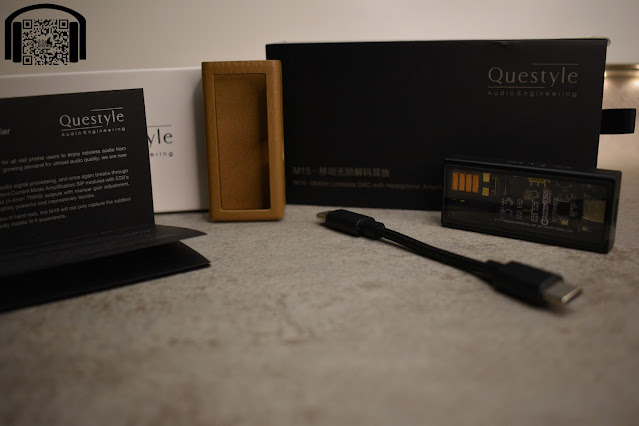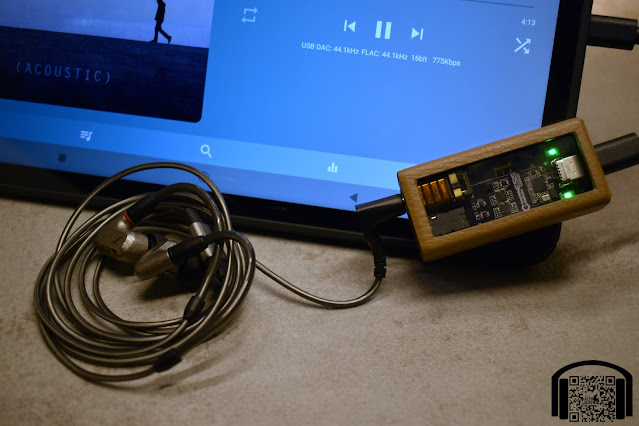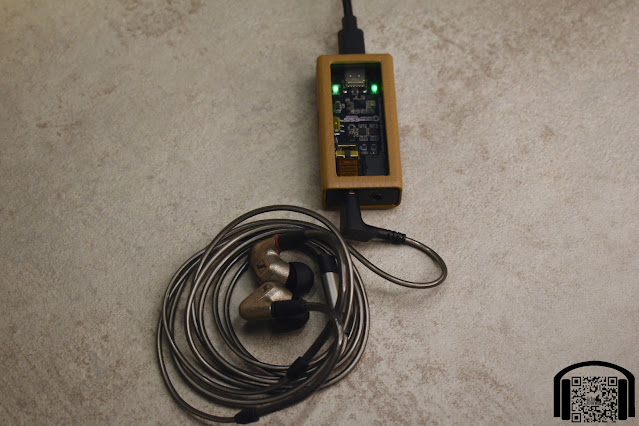- Get link
- X
- Other Apps
English | Español
Also available on YouTube in Spanish: Acho Reviews YouTube
The Questyle M15 has been sent to me by Questyle in exchange for the publication of this review. No specific requests or comments have been made and, as always, I will aim to be as sincere and unbiased in my review as is humanly possible.
You can find the official page for the M15 here: https://www.questyle.com/language/en/m-15/
As always, this is a non affiliate link.
Intro…
As this is going to be my last review of 2022, I wanted to end the year on a positive note, therefore, although I have been using the M15 for a while, I have saved the review until now. That is already an indication of what I think about the M15 but I am going to explain in detail what it is that has drawn me into this little (depending on what we compare it to) dongle.
Earlier in the year I reviewed the CMA15, which was (is) an amazing product, offering a lot in a single package even if the price is not exactly budget friendly (depending on your budget of course, there are much more expensive things out there).
Around the same time, Questyle launched the M15, a small dongle that is powered by USB from the host device, which got a lot of favourable opinions. I didn’t get a chance to try it out at the time that it was recently launched and to be honest, while I was interested, I really was not in need of a dongle style DAC. As you all know, my main portable set up is the iFi Gryphon, with the Go Blu being my pocketable option and when I really need to go smaller, well, I have a bunch of Apple dongles stored in all kinds of places which do the job.
I did try out a few other dongles, the most notable probably being the S9 Pro and the iFi Go Bar, and while I liked the Go Bar, I didn’t really feel that it gave me anything that I didn’t already have.
Fast forward some months and Questyle very kindly offered to send me the M15 and I was happy to give it a try. As a fan of the CMA15, I was interested to see what the brand could offer at the other end of the scale, in a tiny package that retails for just under 235€ (at the time of writing this review). Now that is not exactly a budget offering either (although it is a little cheaper than the iFi Go Bar) and I expected it to be good, but I wasn’t really counting on liking it as much as I actually do.
So, enough rambling for this year, let me get on with my last review of 2022 and explain what it is that I like about the Questyle M15.
Presentation…
There is nothing really notable about the presentation of the device. It arrives in a small black box, well protected by the foam surround, and the only other accessory is a short (well made) USB-C to USB-C cable. As I said, nothing really to mention.
What is worth mentioning is the protective cover that Questyle included in a separate small box (this one white) and is available as a pack on their website for no extra cost (again, at the time of this review). The sleeve is made of leather and is available in a selection of colours, the one I received being light brown (something I am fond of).
Build and aesthetics…
While the build quality seems to be very good, where the M15 stands out from the rest is in aesthetics. One side of the unit there is a transparent window that allows us to see the internals of the unit, that is the circuit board etc. While seeing a circuit board may not sound like much of a big deal, I like it, and it also stops us wondering about what level of workmanship may be inside the device. They also mounted the indicator LEDs on the board so they are visible through the window.
As far as the case, it is also very well built and has an open side to it, allowing us to still see through the window of the device. It is a very good fit and protects the device well, except for the open side of course. I am not sure how the window will stand up to scratches over time but I’m sure it would be easy enough to adapt a small piece of glass protector if it is something that worries you.
There is also a cut out on the side of the cover which allows easy access to the gain switch. This is something simple enoguh but not all brands actually take it into consideration.
Functionality…
There really isn’t anything complex about the M15 that would need explaining, but let’s go over it briefly anyway.
On the bottom of the unit we have the USB-C connector which is where our source device connects. On the side, we have the gain switch that slides to either low or high gain. On the top of the device we have a 3.5mm unbalanced output, together with a 4.4mm balanced output.
There are two LEDs on the circuit board that are visible via the transparent window. The first shows the set gain level (green for low and red for high). The second, which will only light up when the device is playing and has earphones connected, shows us the format of the file we are listening to, green indicates 48kHz or less, red indicates 88.2kHz PCM (or above) and DSD64 to DSD256.
That is it. Not much to explain.
I have tried the M15 on multiple Android devices and on multiple PCs and while there was an issue with MQA playback on Android at first, an update to Tidal fixed the issue, so the blame can obviously be directed at Tidal.
One thing I have found as an issue is that, when using the M15 connected to a Windows 10 PC (I don’t have any 11 machines, thankfully 😉 ) and running Tidal in exclusive mode, each time there is a track change, the volume jumps to 100%. This is something that could be a problem and I recommend that you either avoid Tidal in exclusive mode on PC or at least try it without your favourite IEMs connected (and certainly not in your ears) to see if it happens also on your machine. I think this is something related to the Tidal software as it has not happened to me with any other media player software (nor with Tidal on Android) but is certainly worth being aware of.
Sound…
Judging the sound of a good device (and the M15 is certainly that) is something that I find difficult, as I can never be 100% sure of what I am actually hearing and what is just something that my brain thinks I am hearing. I have said many times that the brain is the most important part of audio, as we can not only interpret things in a different way, but can also experience things that may not actually be there.
Yes, it is possible to do triple blind ABX tests to see if we can really notice a difference between two amplifiers or DACs, and I have no doubt that the vast majority of us would fail, but at the end of the day, listening to music is about enjoyment (at least for me). That means that if I am listening to something and I really enjoy the sound, then I really don’t care if 95% of the sound is just my brain telling me that I am hearing what I want to hear, I mean, at the end of the day, I am doing just that, hearing what I want to hear.
In the case of the M15, I have been using it with quite a few sets of IEMs that I have been testing over the past weeks, plus some more that I will review soon, and I have to say that I really enjoy what the M15 has to offer.
It may not be the most powerful of devices, although I do not have measurements, but in comparison to the Go Bar, it does seem to have a lower output level. However, for IEMs, I have not found that any of the IEMs I have tested via the SE output have needed me to switch to high gain, much less in balanced mode.
As an example, I have mainly been using the M15 connected to my android tablet, using UAPP, and my usual listening levels have been between -24dB and -26dB (depending on track and IEMs used), so plenty of power left. With planar IEMs, such as the Talos or S12, I have been using the balanced output but have not noticed any lack of power or performance with these IEMs.
It also does a decent job with over ears, especially easier to drive ones. With the HD6XX I was very pleasantly surprised with how well they work with the M15. I wouldn’t say that it is the best I have ever heard from the HD6XX (it won’t be replacing the Feliks) but it is plenty for my listening levels and the performance is better than a lot of other options I have tried with these headphones. With more difficult to drive planars, such as the Arya v2, it again reached my listening levels without issue, although I don’t feel that it was quite capable of driving them to the best of their abilities (which is to be expected from a dongle).
The sound itself I find to be extremely detailed but never harsh. Now, as I already said, these are completely subjective opinions, so take that for what you will, but in comparison to my main IEM set ups, the Gryphon and the Go Blu, I find that the M15 seems to be a little more airy, giving a sensation of more detail and a little less warmth.
However, even if it presents less warmth than the iFi options, it still stays a long way from being harsh or cold, something that I did find with the S9 Pro for example. The S9 Pro I also found to be something that potrayed lots of details, yet at the same time, I got the sensation that the details sounded forced, as if they were being pushed at you. The M15 gives me no such sensation, is presents the details in a way that they are very easy to focus on but never seem to be “in your face”.
With IEMs that can have a little bit of harshness in the higher ranges, or with tracks that are also on the harsh side, I don’t find that the M15 adds any extra harshness at all. With tracks and IEMs that are on the other side of the scale, a little too warm (or even bloaty) in the low end, I find that the M15 actually seems to tighten it up a little, without actually removing quantity.
If I had to explain the overall sound of the M15 in one sentence, it would be “clean, neutral, natural and smooth”.
Conclusion…
As I said at the beginning of this review, I wanted to end 2022 on a positive note and the experience I have had with the M15 is nothing but positive. I have paired it with a lot of different combinations and while it wouldn’t be my first choice for power hungry over ears, for everything else I have found that it is just a wonderful little device.
I am someone who prefers cables when possible and while I really enjoy the Go Blu for what it gives me in a bluetooth package, when connected by cable, I much prefer the M15, at least for the IEMs that I use regularly (and those that I have been testing) with the music that I listen to.
It is not going to replace the Gryphon as my main test device for reviews, as the Gryphon has (apart from great sound) so many other functions that make it a perfect (trans)portable device. However, for a compact device that provides excellent sound, the M15 is going to become a main part of my listening experience on the go (or even just relaxing on the sofa).
Therefore, with the Sennheiser IE600 connected to the Questyle M15 and my favourite albums, I conclude my reviews of 2022 in the best way possible!
All FR measurements of IEMs can be viewed and compared on achoreviews.squig.link
All isolation measurements of IEMs can be found on achoreviews.squig.link/isolation
To comment or contact, visit any of the following social media platforms:







